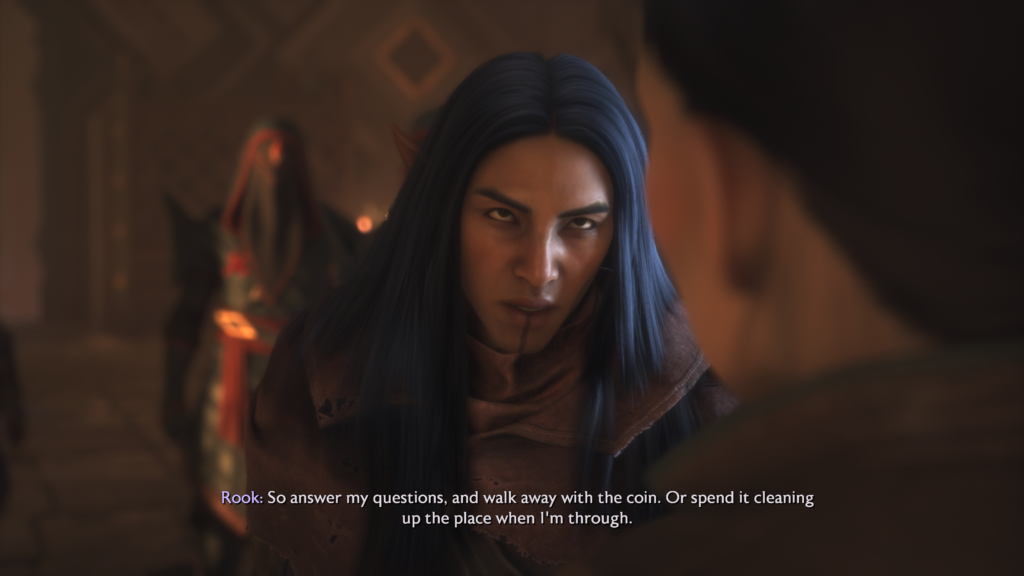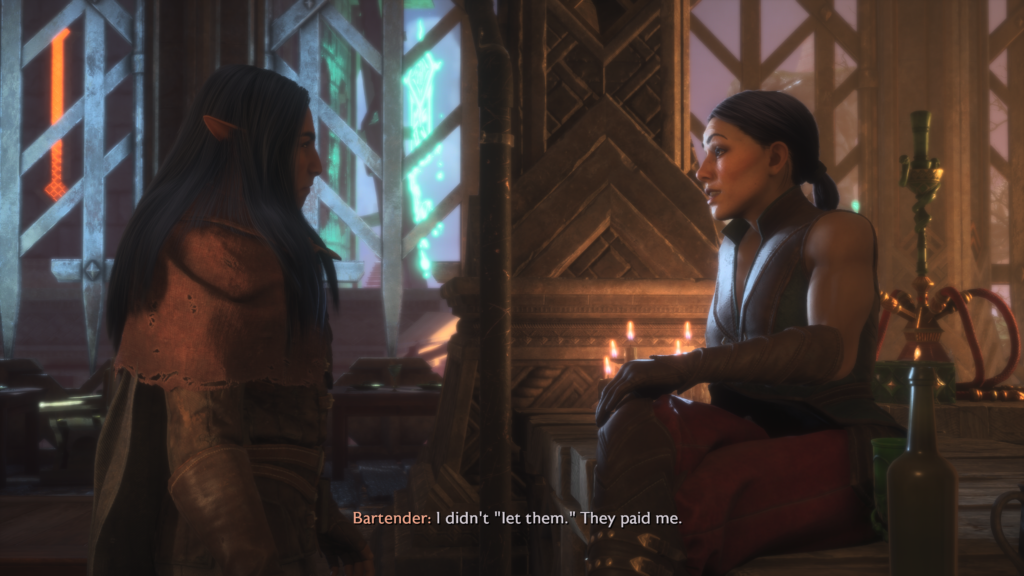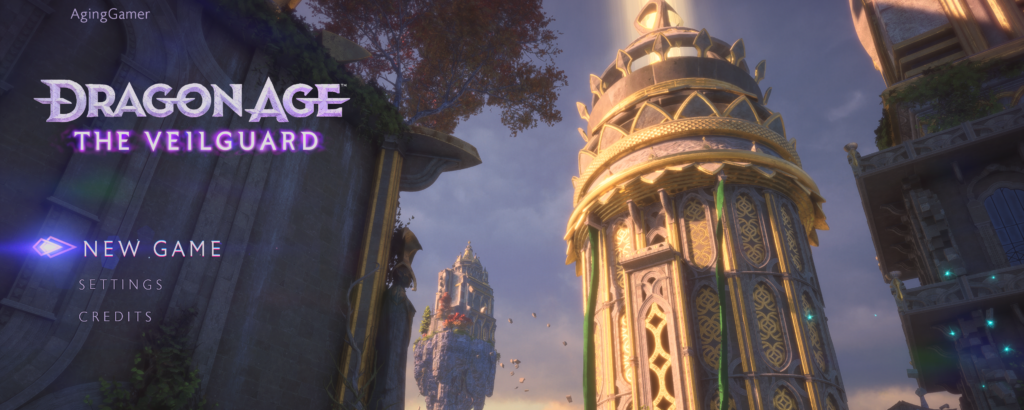Dragon Age: the Veilguard- hereafter referred to as ‘Veilguard’- released on October 31: at 9:00 AM Pacific time where I live. I’ve been having an absolute blast playing it since that moment. I think it is safe to say that Bioware has created a great game.
This isn’t a ‘proper’ review as I don’t think I’m far enough along in the story yet. I haven’t found all the companions I understand exist in the world, for one thing. Instead I want to talk a bit about some of my early impressions of Veilguard’s mechanics and why they are making me happy.
Rich character creation

Character creation in Veilguard is a fun process that could have taken me hours if I wasn’t careful. To start things off you choose a race/lineage, a backstory, a class, a general appearance, and a gender identity. You also get to make some choices about how you want to ‘remember’ the events of the past relating to the previous Dragon Age game, Inquisition.
Note that you can be ‘male’ but use different pronouns- I had no trouble at all with that being an option. But did have a comical bit of difficulty with the ‘Past adventures’ part of things. I unintentionally ended up creating my ‘Inquisition’ character as a female that presented as a male, which made it impossible for me to choose the person I had romanced in that game. It was an easy mistake to make, but somewhat confusing when I got to that point in the ‘Past adventures’ selections.
But the basics of appearance are really just the start. You can drill down into extreme detail regarding exactly how your facial and body features appear. You still have to be consistent with the ‘base’ choices e.g.: elves have pointy ears and Qunari have horns. But your elf can have lopsided ears, blue eyes, an afro or be bald… I was somewhat overwhelmed by choices, but tried to stay focused. I was somewhat aiming for a “Lord of the Rings” movie elven mage, but I could have ended up (I am sure) with a ridiculous monstrosity if I wanted.

High-octane combat
The combat in Veilguard is action oriented: things move fast, there are big explosions and people racing around. If you are like me, there is sometimes a lot of ‘kiting’ the main monster around while waiting for healing timers to click down- in MMOG terms, my mage has an aggro management problem. In short: it is more tactical than strategic, which is a departure from previous Dragon Age games.
There are good elements of strategy as well, though. An ‘action combat pause’ is a button click away, allowing you to select abilities for yourself or your party members to use. Some abilities can be ‘stacked’ in sequence to form combos that multiply the effect: the combat pause does a good job letting you know when your companions have such abilities ready to use.
Battle buddies
Speaking of companions, you are limited to two of them at a time for a total party size of three including yourself. And you can’t give them detailed ‘positioning’ orders either, although you can tell them who to attack at a given time. And arguably for myself, the most important thing you can do during the combat pause is instruct a companion to heal you.
Combat healing requires that your companion have a suitable healing ability ‘prepared’ (in their ‘readied’ abilities). It seems that most if not all the companions have some kind of ability to perform healing somewhere in their skill trees, although many will not have it readied. Given the nature of the way I play at least thus far in the game i.e.: drawing all the aggro it is important to me that my companions all have their combat heal abilities at the ready. You also have healing potions available, but are limited int terms of how many you can carry e.g.: I have three such potions, which rarely is enough to get me through a boss fight.
Difficulty choices
Difficulty settings in Veilguard are extremely flexible. There are five ‘preset’ difficulty levels in order of challenge: Storyteller, Keeper, Adventurer, Underdog, and Nightmare. I play at the ‘Keeper’ level and am quite happy there: generally speaking, the only time I die is when I take on a foe that is significantly above my level. For example- my character was level 10 and died repeatedly to a level 25 demon before I clued in to the level difference.
But you can also ‘customize’ the difficulty settings in great detail if you find the presets don’t suit your preferences. This customization has a setting name of its own: “Unbound”. Unbound allows you to tweak a dozen or so settings covering things from aim assist through enemy health and whether you can even be killed or not. I haven’t played with these settings yet and haven’t felt a need to.
Enjoyable companions
My preferred style of game is a role playing experience that has a deep narrative and interesting characters that you can gradually get to know. Vanguard ticks all my boxes in this regard, and I am particularly enjoying my interactions with my companion characters.
I don’t yet have a full ‘roster’ of companions, but the ones I do have are more than just paper cutouts.
Neve is a detective in the true sense. She doesn’t like to act until she has spent time collecting facts and evidence. You can see this in how she talks to other characters and interacts with the developing story. She doesn’t accept the idea of ‘gods’ walking amongst us at face value, and reserves judgement on their true nature.
Harding has a tough exterior but both in action and in written notes you find it becomes clear that she is constantly questioning herself and her actions. Lucanis the assassin is elegant and seems at first to have a ‘prickly’ disposition, but seems to have a sense of humour about himself and his situation. And Belara… the perky scientist is irritating to me at all levels despite being a truly ‘nice’ person.
The fact that the game is confident enough to let the characters be themselves instead of forcing you to like them is great to see. I don’t like Belara that much, and she even mentions in passing that she has a hard time keeping friends because of her excessively upbeat and gregarious nature. She might grow on me in time, but the Veilguard isn’t forcing the matter.
I also like the regular background conversations I hear amongst my party members. These chats seem true to each character’s nature but also regularly reveal them to be three dimensional instead of stereotypes. I also have enjoyed some quite interesting conversations with non-companion characters. Veilguard does not skimp on the background.

Itching to get back to it
Every time I stop playing Veilguard I almost immediately start thinking about when I will be getting back to it. This is a pretty strong indicator that it is ‘working’ for me. I want to know more about the character stories, to find out who is really behind the happenings in Tevintor, and generally sink myself more deeply into the world.
I expect that I will be playing Veilguard far too much over the next several weeks. I don’t think I will be able to stay away from it for more than a day or so and, assuming the estimate of ’50 to 70 hours of gameplay’ is approximately true, I expect I will likely finish it wanting a lot more. Veilguard, for all its differences from the previous Dragon Age games, really feels like a return to form for Bioware.
As I said at the beginning of this post, this isn’t a review. But barring major problems or disappointments, I expect Veilguard will be a ‘five out of five star’ game for me.
